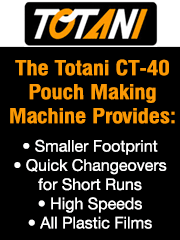Amidst Staffing Shortages, Working Hard Is the Norm
- Published: June 01, 2002, By Yolanda Simonsis, Associate Publisher/Editor
This year marks the 47th year that Paper, Film & Foil CONVERTER has published the converting industry's most respected and complete Buyers Guide.
So much of what you see within PFFC goes unnoticed in terms of the time and effort required to assemble the information we provide. All issues have their idiosyncratic problems, but a buyers guide comprises a special breed unto its own.
As for myself, having had in past years the “privileged” task of proofing the PFFC Buyers Guide alone, I can appreciate the monumental effort put forth — along with frequent late nights — that a buyers guide issue demands if it's to be accurate.
And so I owe a huge debt of gratitude to senior editors Claudia Hine (especially) and Teresa Koltzenburg as well as graphic artist Michael Koch (who did a lot more than redesign the graphic format) and production's Anita Sljivar for shouldering the majority share of the work that made this issue possible. It was made even more difficult without the extra help of our staff editor who was missing in action.
The reason we were short extra help is that Nsenga Byrd Thompson finally delivered a healthy baby boy after being restricted to a “boring month and half” of strict bedrest. As with all hard labor (be it baby or buyers guide) the pain of birth is soon forgotten once the fruit of that labor is held within your hands.
Similarly, as I observe the difficulties industries at large are confronting from an economic standpoint, I can't help comparing their difficult struggles to the labor pains of a world awaiting an economic rebirth.
Interestingly enough, lately I've heard some thought-provoking philosophies that address how we got in this negative-growth-pattern mess in the first place. Ron Schultz of RBS Technologies, Phoenix, AZ, suggested that many dollars were diverted from the manufacturing sector when the dot.com frenzy was in play. Then when the bubble burst, all the money invested in the dot.coms also disappeared.
At IPEX, held in April in Birmingham, UK, chief engineer Keith Fordham of Ashe Converting Equipment, Ipswich, UK, shared another philosophy that warrants repeating: All the anticipation of Y2K problems (that never materialized) resulted in an inventory surplus in the manufacturing sector that has taken until recently to deplete.
Combine the problems posed by surplus inventory (forcing a manufacturing slowdown) with overcapacity along with a 9-11 tragedy, and you can understand why things are the way they are.
The good news is I've heard positive reports regarding a healing economy. The Packaging Machinery Manufacturers Institute (PMMI) says that “manufacturing activity slowed in April but is still showing signs of growth.” Andrew Paparozzi, National Association for Printing Leadership (NAPL) VP and chief economist, expects “print sales to grow as much as 5% from July through December and as much as 7.5% next year. For all of 2002, sales will grow 2.1% to 3.3%, in contrast to last year….” Printing Industries of America (PIA) chief economist Dr. Ron Davis explains, “Some printers already are seeing a gradual positive trend with regard to their business; however, there are still more jobs being lost than created. While the national economy seems to be on an upswing, printers are at the tail end of that growth.”
A better balance between layoffs and new hiring would be a sure step in the right direction. Until then, working hard with fewer people is the norm.













